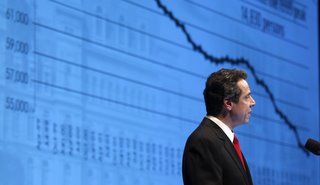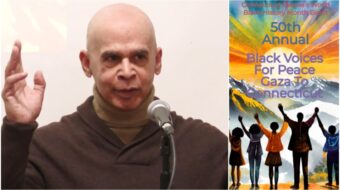
NEW YORK – Democratic Governor Andrew Cuomo presented his proposed state budget yesterday, Feb. 1, unveiling huge spending cuts to social services, especially education and health care.
The $132.9 billion budget – compared to $136.6 billion for fiscal year 2010 – would reduce state spending for the first time in over ten years, meaning that the people of New York will have to do with less public assistance even as the economy has forced many from their homes and jobs.
And while Cuomo’s proposed cuts are deep, the numbers could mask some of the problems the budget will create. The budget includes $2.85 billion in cuts each to education and Medicare funding. Since New York receives federal matching grants for Medicare, the actual cut to Medicare would total $5.7 billion.
“These proposed cuts are significant and, if enacted, would impact the classroom both directly and indirectly,” said New York State United Teachers President Richard C. Iannuzzi.”
Saying that the executive budget is a “recipe for disaster” for education, Iannuzzi continued, “I can’t say that we share the executive’s belief that a cut in state aid this significant – coming on top of a nearly $1.9 billion decrease over the previous two years – can be absorbed without teacher layoffs and the loss of other important education professionals.”
Indeed, New York City mayor Michael Bloomberg suggested, then hastily retreated from, the idea of laying off over 20,000 city teachers.
Currently, New York State’s budget shortfall is about $10 billion. Essentially, Cuomo proposes to fill $5.7 billion of that hole with $8.55 billion worth of cuts.
In addition, Cuomo proposed an across-the-board spending cut of 10 percent for all state agencies, and 2 percent for local governments.
Danny Donohue, president of AFSCME Local 1000, the Civil Service Employees Association representing state employees, said he was ready to work with Cuomo but, “Slashing aid to our communities, to our hospitals and nursing homes, to our schools and disproportionate cuts in state operations does not represent any new direction.”
“New direction” refers to Cuomo’s announcements that he would propose budgets in a new, more transparent way.
The budget dance had become somewhat of a routine over the past few years. The governor puts forward a proposal with draconian cuts. After that, labor and other public interest groups would rally to restore some of the funding. This year, however, while Cuomo has listed the amount of money to be cut from the above-mentioned programs, he hasn’t said how. Instead, he’s created a committee to deal with health care spending and a committee to deal with education spending.
While the makeup of the education committee is not yet known, Cuomo appointed prominent health care labor leaders to his health costs panel. Some have speculated that this is supposed to signal a compromise, while others have suggested Cuomo is simply trying to keep labor quiet and divided as the budget process moves forward.
Giving credence to the theory that Cuomo is trying to squelch labor’s influence in Albany, he’s helped create the pro-business Committee to Save New York, composed mainly of business representatives whose aim is to rid Albany of “special interests,” their code word for organized labor.
The New York City Council’s Progressive Caucus is concerned with Cuomo’s tax proposals. He is pushing for a yearly 2 percent property tax cap, which many support, but, in the words of the caucus, “it will bleed the poorer districts where schools are already losing teachers and resources, further widening the education gap between New York’s rich and poor.”
Indeed, Cuomo’s budget contains hardly anything in the way of revenue generation, aside from less than $500 million to be raised mainly through fixing some tax loopholes and changes in the gambling law. Labor and its allies have argued that Cuomo should push to extend the sunsetting “Fair Share” temporary tax surcharge on those who make over $500,000 yearly. The surcharge, enacted after public outcry, brings in a substantial amount, several billion dollars yearly.
“Most New Yorkers support extending the existing income tax surcharge on those who can afford it,” said the Progressive Caucus, which also went on to propose “a tax surcharge on household income over $250,000, to reclaim the ‘Bush era tax cuts’ for the wealthiest 2 percent.” This plan, caucus members say, would generate $8.1 billion, covering almost the entire deficit without the need for service cuts.
The Progressive Caucus, as well as CSEA president Donohue, NYSUT and others urged that the budget be “fair and inclusive.”
Photo: AP

MOST POPULAR TODAY

High Court essentially bans demonstrations, freedom of assembly in Deep South

Zionist organizations leading campaign to stop ceasefire resolutions in D.C. area

U.S. imperialism’s ‘ironclad’ support for Israel increases fascist danger at home


UN warns that Israel is still blocking humanitarian aid to Gaza






Comments